Hi,Tom
24.9.2018
OK, this enforces my suspicion of a shunting air-route ending
below the restriction ring
in a PRIVAT BONFIRE!
How about the ashbunker itself? Or it’s sealing?
Confirm?
Hi,Tom
24.9.2018
OK, this enforces my suspicion of a shunting air-route ending
below the restriction ring
in a PRIVAT BONFIRE!
How about the ashbunker itself? Or it’s sealing?
Confirm?
Got the nozzle out. It is drilled to 5/16’s of an inch in diameter.
Reply to post #902;
It sounds like you are saying the air is coming down past the restriction and to the reduction zone by passing between the fire tube wall and the edge of the restriction ring or the edge of the top plate of the reduction zone. I though this would seal with ash.
I don’t know where there would be any seal in the ash bunker.
I have always questioned those slits in the top of the reduction tube below the top plate of the reduction zone.That would be a good place for air to come between the fire tube and the top reduction plate. The air could come across the bottom of the top plate of the restriction zone and out through the slit that is suppose to fill the ash insulation. Then create your private bonfire.I’m baffled TomC
Hi,Tom!
24.9.2018
I have a lower route in mind:
The first plate above the ashbunker, upon which the reduction tube stands.
It was bolted upwards to something… the leak possibility was discussed during the construction phase…
Then the horizontally creaping air would rise up through the ash insulation and blow in just UNDER the restriction ring.
Show the “cut-through”— drawing, it will clear the circumstances!
Max; I think you are remembering my previous design. Here is a section view of the rim/ two disk brake drums that I was running before this latest design.
Believe it or not, I can’t find a drawing of this latest design. You may be thinking of some designs using the rim/ two disk brake drums with many of your suggestions; such as 10 nozzles, rectangular slide in grate, and using ash for insulation in the oxidation zone and reduction zone.
Hi, Tom!
25.9.2018
Thanks for looking up!
Dispite the imperfect detail level of this version, it shows
that whole the hearth is hanging inside the “ashbunker” vacuum?
So, the ashbunker is not in reality placed below the grate-level as of today?
That means, that whole the heart is still surrounded by the
“final succing vacuum” of the motor. (On the mixer level)
================================================
Only an up to date drawing can solve the leaking air passage!
Until that is available, I can just produce useless fantasies!
I apologize for cutting some of you out of this conversation . I sent these directly to Max yesterday. To post picture on DOW I always mail the pictures to myself as my E-mail program cuts the pixels down, which Chris asked us to do. Rather than post the pictures to all of you, I just forwarded the E-mail I received to Max. Sorry for cutting some of you who are very interested in Max’s every word. Hopefully we will get an answer from Max
Ash pit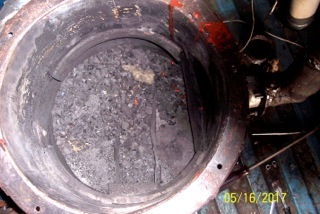
Nozzle lay out on fire tube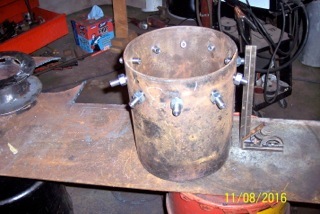
Air manifold around nozzles;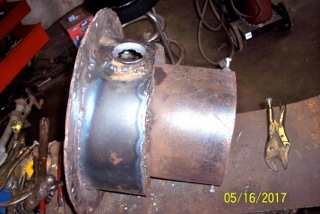
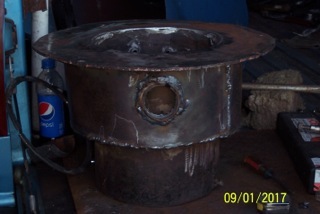
Reduction bell;
Bottom of RB with grate hangers;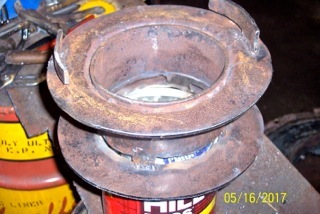
Grate;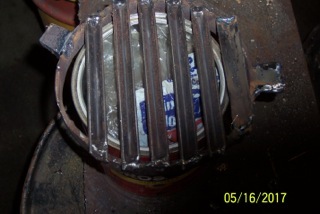
Grate mounted to RB;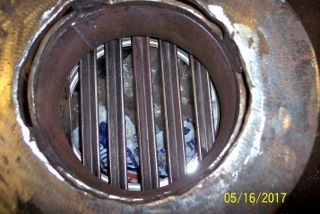
RB in fire tube;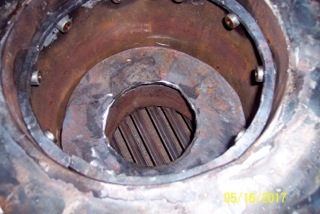
Restriction on top of RB;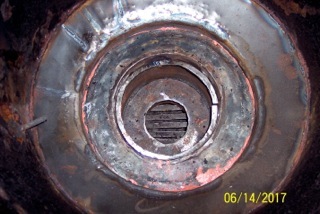
Sketch-up of system;
( Max; drawing changed slightly from what I sent you ) TomC
Hi,Tom!
26.9.2018
The drawing, sketch (pic.11)
dated: 25/25/18, 09/26/2018
Without measures again! Otherwise normal. It could have the airheating mantle all the way down.
There is ash inside the hearth wall, so no serious cooling! And it’s comming back.
Your last notice about the nozzle measure = 5/16" = 7,8125 mm.
The (bolted) seam between the silo and and hearth? Silicone or gasket?
But first a “grand question”! The silo lid! When did you a smoking backflow test last time?
Shure not at last drive! You have the Kirby forward/backward blower…
Temporary woodplug, if no backflap. Don’t waste tape! (At the air intake)
Don’t fill-up more than 2" over the nozzles before you can confirm that the nozzle-blast REALLY works!
Are your nozzle-nuts properly welded? FULL SEAM?
It would not hurt to check the ash-lid too!
Hi,Tom!
27.9.2018
That rectangular-profile band laying on the nozzle-shafts makes me suspcious;
it may develop a cavity-ring below it, but it does not reach the nozzle-tips!
And the fuelflow abowe gets irregular:
Stop — go — stop irregular avalanches…
Anyway, the aim is to make a sucction—collecting ring—cavity
to provide a common space from which all nozzles have easy access
to suck up return-gases back into the center glow.
It has to reach horizontally (from the periphery inward to the nozzle-tips +
1/4"—1/2" overhang) just abowe the airbeams.
to be able to assist the nozzles’ sucction activity.
The overhang will also protect the nozzle-tips from direct contact with white-glowing char! (lifetime!)
The fuel flow ABOWE this “obstruction” is best served with a conical ring-roof
as presented in mess. 635.
Is image24.jpg a hand sketch? I wish I could draw like that.
Rindert
Me too!! I can’t even draw that well with a drafting table and tools. 
Thank you for the kind words. I worked on taking the gasifier apart with out removing the hopper. I was working on my head in the hopper. When I got done, I could have drawn the sketch in charcoal off my finger tips. My wife had some very serious words about cleaning my “sooty” cloths. TomC
I am sad to say that I may have to get out of the DOW groups. Trying to “revamp” my gaifier is a very dirty job and is seriously causing problems with my wife. I have always been listening to new ideas and trying to incorporate some of them. As I look back much of what I did was sorting the “fly shit out of the pepper”. Most of these changes were not going to make big performance changes. I would just as soon go back to basic construction and not try to make an Imbert compete with Mr. Waynes little Dodge V8 and his design. ( that for me has become the standard of performance )
The sad part is I do not have the tools anymore to build a new gasifier It has been fun for the last 18 years but all good things must come to an end. It has been great meeting you both in person at Argos, and just on line.
May you never run out of lemons and if you do just enjoy the smile. TomC
I need an unlike button! My dad always said "if you don’t get dirty, you ain’t doing nuthin. I love reading your posts. Please don’t quit.
Hello Mr. Tom .
What Don said .
It wouldn’t be the same without you 
Hi, Tom!
28.9.2018
Pilots do not quit in midair!
Keep you overall in the workshop and home sootfree.
Hey Tom,
I very seldom comment on anyone’s individual style, but we need people on Drive on Wood that are not afraid to tell it like it is. It helps the overall community. You are out there doing this and that, getting dirty actually burning wood and driving, making great drawings, asking hard questions, etc., etc. That is how the state of the art gets advanced. Take a break, but hang in there. I would really like to see you come to Argos again, just bring yourself and a notepad.
I like the “orange” hand cleaners, GoJo, Simple Green for cleaning carbon black and grease, Tide, Oxy-Clean, and like Max said: keep dirty overalls or something similar in the shop. maybe a small shower stall out there. 


Tom,
Even if you decide trying not to get as dirty (keep your head down for a while and it will blow over), I see no reason for you to quit participating on the DOW forum. You have a rare talent dressing your thoughts in words and I enjoy very much reading your posts.
Hi TomC,
Ahhh. . . . many of us have the same types of “significant other” problems.
If not black soot dirt, then Time&Money diversions. My wifie’s grand objections starting in 2007 for me and peaking in ~2012. I had to quit my traveling-to-helps, active systems developing(improving), daily readings, and postings.
Now I figure your building fire probably figures into her ire . . . a lot.
So ok to have to step back a bit. Gain perspective.
Do realize however that you are in a very small select group of one-in-a-million who has actually operated and trial&error soot-hands learned to operated a wood gasifer in this Millennia. Last millennia operators are all aged out and almost all gone now.
Your soot-hands experiences: wisdom’s gained, voiced, just may keep a younger moving forward and safe.
Regards
tree-farmer Steve unruh
Hi, Tom!
30.9.2018
Why did you take the gasifier apart, and “dive” in it, instead of smoke-testing the hopper-lid?
A heavily leaking hopper lid could have given a “bypass flow” making the nozzle blast floppy ineffective.
Resulting in letting the flamefront retrete down to the restriction, where the smaller
flow-area could have sustained the destructive clinker making.
You have repetedly had problems with the silo-lid! Ever resolved it?
Remember “satelite-lids” flying on the road"! (can’t help it!)
Are the hindges “flimsy” in the horizontal plane?
They need to control the settling geometry so, that the lid is settled correctly after what-ever “bangs” or lenient puffs!
Control!
Satisfaction comes from solving challenges!
Hi, Tom!
30.9.2018
The fade-away power can also happen, and happens always to me, if I extend a driving lap (time) over the silo’s volume limit.
The power slowly fades away, the speed gets lower and lower until the motor just dies.
It usually takes about 20 minutes on a free road.
(From observing the phenomenon)
This just to comparasion, when FUEL goes low with a tight lid!
No “satellite-lid” here"!
It has happened to me that there is just a tiny layer of “individual” charbits on the grate, one layer.
And then first the motor has died. But no clinker, what so ever!
The power reduction starts just when the last fuel bits reveal the nozzles.
The power reduction is a result from having no more humidity, or tars or any hydrocarbons which gives hydrogen.
This as a reference with a lid mechanism in order.